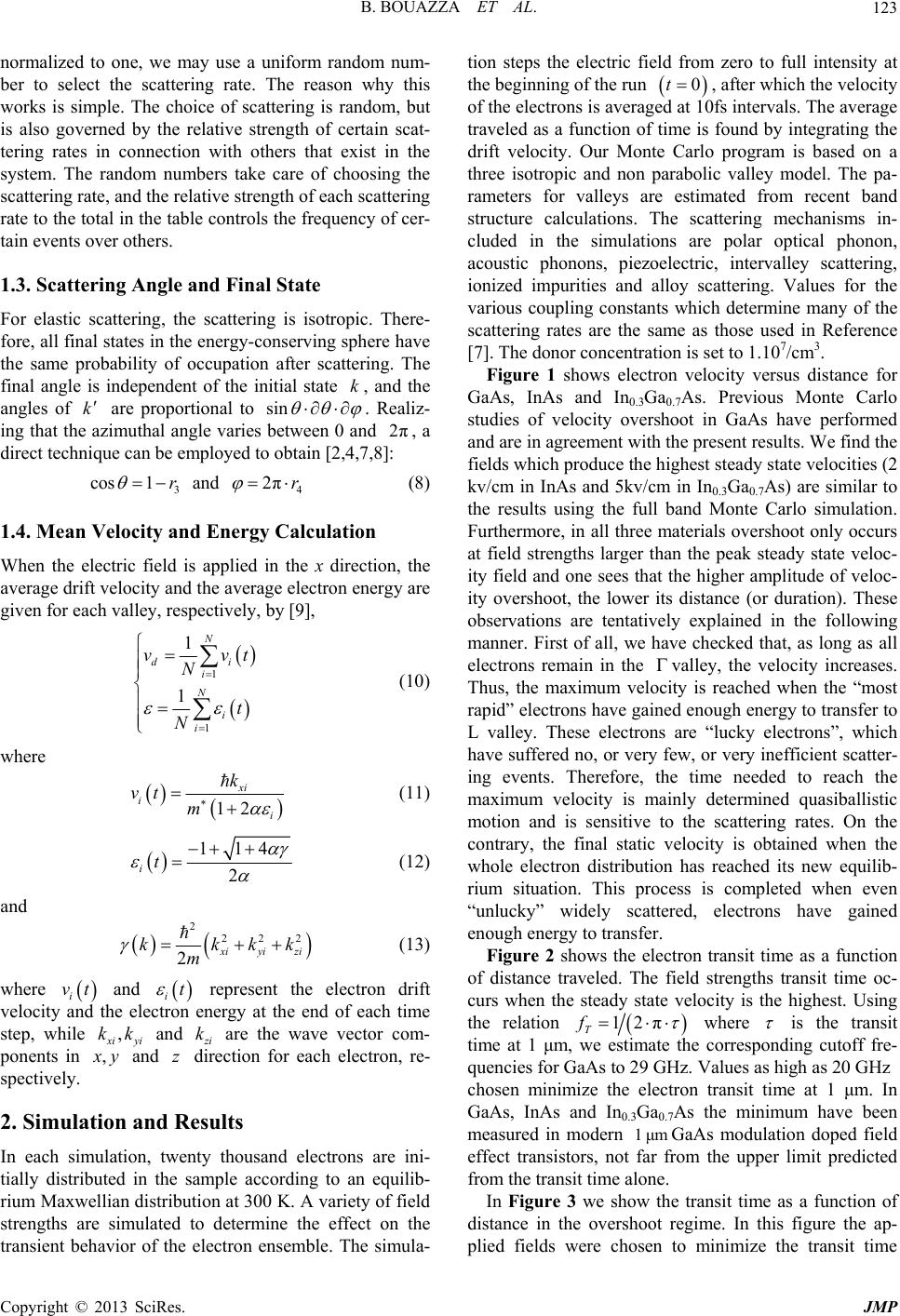
B. BOUAZZA ET AL. 123
normalized to one, we may use a uniform random num-
ber to select the scattering rate. The reason why this
works is simple. The choice of scattering is random, but
is also governed by the relative strength of certain scat-
tering rates in connection with others that exist in the
system. The random numbers take care of choosing the
scattering rate, and the relative strength of each scattering
rate to the total in the table controls the frequency of cer-
tain events over others.
1.3. Scattering Angle and Final State
For elastic scattering, the scattering is isotropic. There-
fore, all final states in the energy-conserving sphere have
the same probability of occupation after scattering. The
final angle is independent of the initial state , and the
angles of are proportional to
k
ksin
2π
cos
. Realiz-
ing that the azimuthal angle varies between 0 and , a
direct technique can be employed to obtain [2,4,7,8]:
3
1r
and 4
2πr
(8)
1.4. Mean Velocity and Energy Calculation
When the electric field is applied in the x direction, the
average drift velocity and the average electron energy are
given for each valley, respectively, by [9],
1
1
1
1
N
di
i
N
i
i
vvt
N
t
N
(10)
where
12
xi
i
k
m
i
vt
(11)
114
2
it
(12)
and
222
2
2
iyizi
kkkk
m
(13)
where
i
vt and
i represent the electron drift
velocity and the electron energy at the end of each time
step, while
t
,
i
k
yi
and
k
i are the wave vector com-
ponents in
k
,
y and direction for each electron, re-
spectively.
z
2. Simulation and Results
In each simulation, twenty thousand electrons are ini-
tially distributed in the sample according to an equilib-
rium Maxwellian distribution at 300 K. A variety of field
strengths are simulated to determine the effect on the
transient behavior of the electron ensemble. The simula-
tion steps the electric field from zero to full intensity at
the beginning of the run
0t
, after which the velocity
of the electrons is averaged at 10fs intervals. The average
traveled as a function of time is found by integrating the
drift velocity. Our Monte Carlo program is based on a
three isotropic and non parabolic valley model. The pa-
rameters for valleys are estimated from recent band
structure calculations. The scattering mechanisms in-
cluded in the simulations are polar optical phonon,
acoustic phonons, piezoelectric, intervalley scattering,
ionized impurities and alloy scattering. Values for the
various coupling constants which determine many of the
scattering rates are the same as those used in Reference
[7]. The donor concentration is set to 1.107/cm3.
Figure 1 shows electron velocity versus distance for
GaAs, InAs and In0.3Ga0.7As. Previous Monte Carlo
studies of velocity overshoot in GaAs have performed
and are in agreement with the present results. We find the
fields which produce the highest steady state velocities (2
kv/cm in InAs and 5kv/cm in In0.3Ga0.7As) are similar to
the results using the full band Monte Carlo simulation.
Furthermore, in all three materials overshoot only occurs
at field strengths larger than the peak steady state veloc-
ity field and one sees that the higher amplitude of veloc-
ity overshoot, the lower its distance (or duration). These
observations are tentatively explained in the following
manner. First of all, we have checked that, as long as all
electrons remain in the
valley, the velocity increases.
Thus, the maximum velocity is reached when the “most
rapid” electrons have gained enough energy to transfer to
L valley. These electrons are “lucky electrons”, which
have suffered no, or very few, or very inefficient scatter-
ing events. Therefore, the time needed to reach the
maximum velocity is mainly determined quasiballistic
motion and is sensitive to the scattering rates. On the
contrary, the final static velocity is obtained when the
whole electron distribution has reached its new equilib-
rium situation. This process is completed when even
“unlucky” widely scattered, electrons have gained
enough energy to transfer.
Figure 2 shows the electron transit time as a function
of distance traveled. The field strengths transit time oc-
curs when the steady state velocity is the highest. Using
the relation
12πfT
where
is the transit
time at 1 μm, we estimate the corresponding cutoff fre-
quencies for GaAs to 29 GHz. Values as high as 20 GHz
chosen minimize the electron transit time at 1 μm. In
GaAs, InAs and In0.3Ga0.7As the minimum have been
measured in modern GaAs modulation doped field
effect transistors, not far from the upper limit predicted
from the transit time alone.
1 μm
In Figure 3 we show the transit time as a function of
distance in the overshoot regime. In this figure the ap-
plied fields were chosen to minimize the transit time
Copyright © 2013 SciRes. JMP